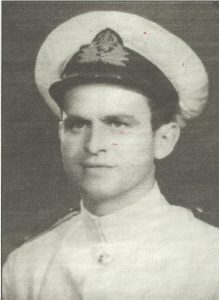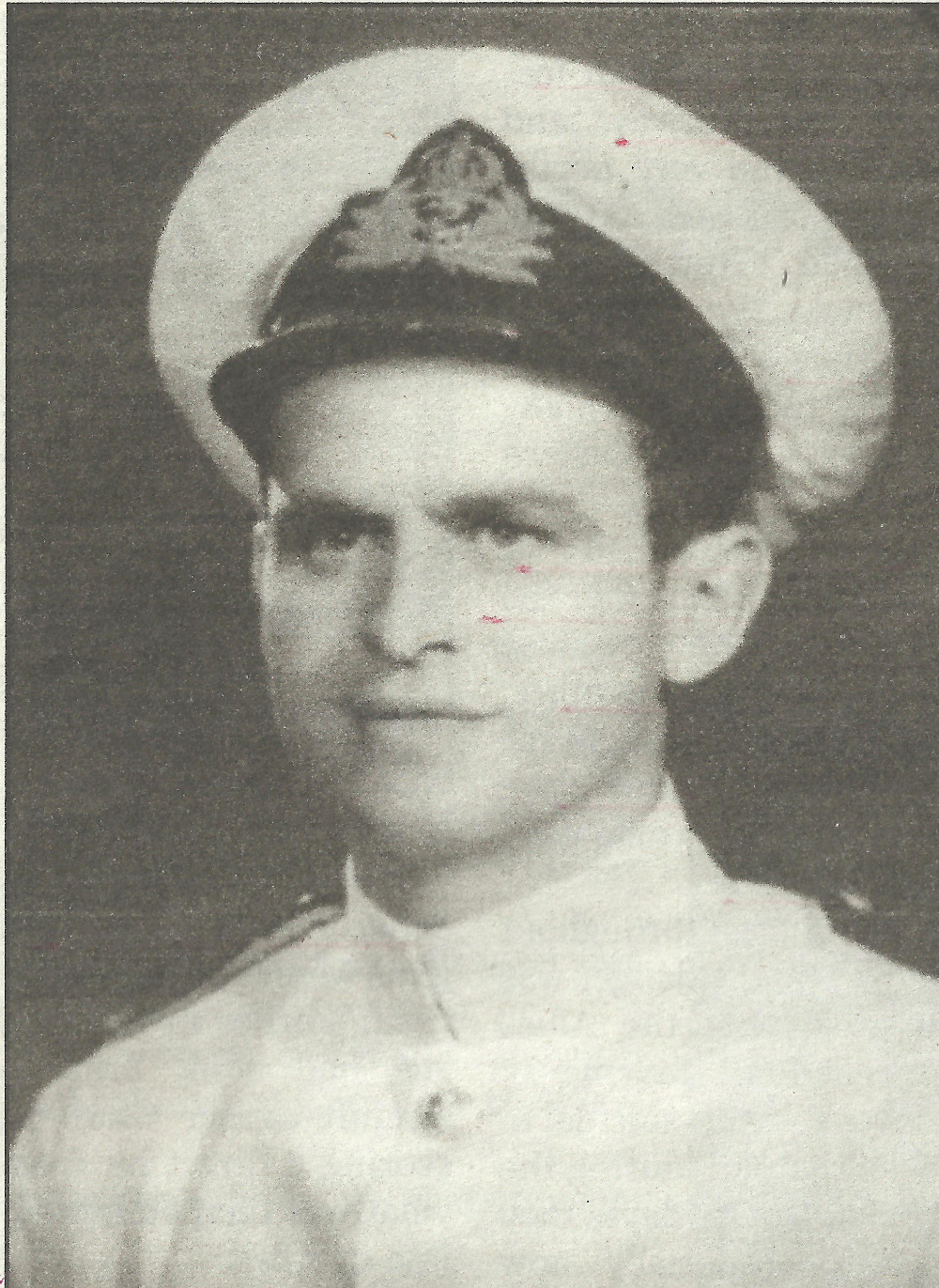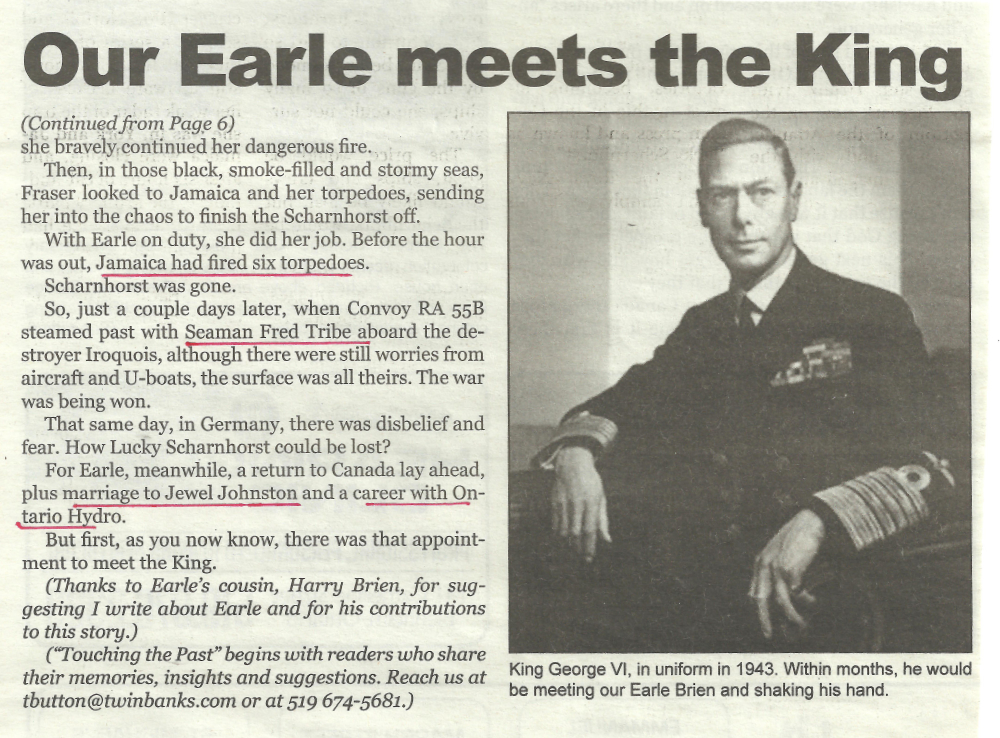


Born 26/01/1917 on Ridge Road in Howard Twsp. The son of Irene Simpson and George S. Brien. Educated at S.S.No. 6 (Scanes) Ridgetown High School. Graduated from Queen’s University with a Bachelor of Science (1940). The husband of Jewel (nee Johnston) of Kingston, ON. The couple were married 27 Mar 1944 in Kingston. The brother of Lloyd. RI 23/02/11.
Enlisted in Kingston in April of 1940 after his graduation from Queen’s. He was loaned to the RN as a radar specialist. He was officially overseas in May 1940. He was decorated by the Russian Government and awarded the Soviet Gallantry Medal for conspicuous work on the Murmansk convoy run. “The young naval officer has seen considerable action especially during the first two years when he was in the Mediterranean theater. He was in the navel engagement with the Schernhorst just after Christmas in 1943 the Nazi battleship was sunk in the North Atlantic“. This battle was also known as the Battle of the North Cape. The Navy Minister announced (1943) that Lieut. Brien was ‘mentioned in dispatches’ for “good services in action against the enemy.”
This battle was the last of the “Big-Gun” naval battles of WWII. The Royal Navy had sent the Battle Ship HMS Duke of York and the light cruiser HMS Jamaica along with the cruisers HMCS Belfast, Norfolk and Sheffield and destroyers Onslow, Milne, Savage, Scorpion, Saumarez and the Royal Norwegian ship to shadow the convoy.
The Navy Minister announced (1943) that Lieut. Brien was ‘mentioned in dispatches’ for “good services in action against the enemy.” Lieut. Brien would later be transferred to “Special Branch” in the Intelligence and Spy service. He later was awarded the Order of the Patriotic War from the Russian government. He was never sure why he was given the award.
The Royal Navy decided to keep Earle and promote him to a Sub-Lieutenant. He served for a time on the HMS Phoebe; one of the Royal Navy’s most technically advanced Dido-class light cruisers. He then found himself in the Mediterranean during the fight in 1941, moving troops into North Africa to take on the Italians and General Rommel Africa Corps. It was while on a run to Tobruk that four German torpedo bombers attacked HMS Phoebe, one bomb striking the ship close to Earle’s station, killing 12 men. The Phoebe limped into the harbor and was out of action indefinitely.
Earle was then transferred to Alexandria, Egypt, where he was assigned to radar duty and promoted to Lieutenant. He was then assigned to the Crown Colony class cruiser HMS Jamacia, operating between Iceland and Norway protecting convoys going to and from Murmansk, Russia. Winston Churchill referred to it as “the worst journey in the world”, beside the horrible weather, this route brought ships in range of the German Navy and Luftwaffe operating out of Norway.
The Bismark had been sunk, the Tirpitz had been damaged and the Gniesenau was bottle up in the Baltic Sea, leaving only Scharnhorst up to the task of starving the Russian (War Ships). The RN had developed a plan to lure the Scharnhorst and her smaller ship into a trap. The battleship HMS Duke of York and the HMS Jamaica along with a flotilla of destroyers would attack the German when they came out to get the convoy.
Britain had superior radar and they had broken the German codes so they had a very good idea of what the Germans where planning at this point. HMS Jamaica beside her six inch guns had torpedo tubes, as well. The Duke of York counted ten 14” guns. If the battle ship could knock out some of the the German guns, the Jamacia could get in close to launch her torpedoes.
The weather could hardly have been worse. Low temperatures and high seas a Force 9 gale at the war ships met at North Cape. The radar operators on the Jamaica could actually see the German shell as they headed towards the British targets. The Duke had done her job, and this allowed Jamaica to launch six torpedoes and the Scharnhorst was gone. The Germans mourned the loss of the “Lucky Scharnhost” and the loss of all but 36 of a crew of 1,968 all ranks. There were no officers rescued after the sinking.
It was some time after the Battle of the North Cape that Earle met King George VI and he extended his hand to Earle to shake it.
Earle was granted leave and returned to Canada.
While in Canada Lieut E. W. Brien married Jewel Irene Johnston at the Chalmers United Church in Kingston, ON. (CDN 4/14/44). The couple had an eastern honeymoon and visited his family before returning to his duties.
After the war, he started a career with Ontario Hydro and moved his family to Ottawa. He is buried there.
ADDITIONAL INFORMATION
| Sources | THH-HR, RRWI-RH, ESUC-RH, RIN 4/11/15 T.Button, RIN 17/08/16 – J. Wickwire article “We were just like brothers”. |
Notice something wrong with this record? Or, do you have something to add? Report it using our online form.



